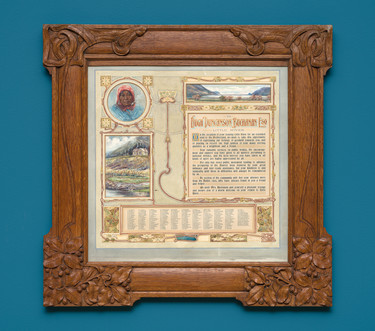
Robert Herdman-Smith Framed Presentation to Hugh Duncanson Buchanan 1908. Ink and watercolour in oak frame. Collection of Akaroa Museum
Robert Herdman-Smith's Framed Presentation to Hugh Duncanson Buchanan
I’m often drawn to art that’s attached to a specific time and place, and so it was that I came across Robert Herdman-Smith’s beautiful piece – commissioned in honour of the departure from Little River of a wealthy landowner (Hugh Duncanson Buchanan) in 1908. Behind the intricately carved wooden frame, the tiny perfect lettering embellished with paintings and art nouveau-ish decorations, is a story that I’d like to know more about.
Who was this man? We read that he was involved in many aspects of Little River life, like farming, politics and sport. He was said to be kind and sympathetic to “those in difficulties”. But why did his leaving prompt such a gift? And why is it that “no section of the community will feel [his] absence more than the Native race”? The explanatory notes provide some clues but don’t exactly answer the questions that occur to me. I find myself wondering whether this man was truly the beloved community leader the words seem to suggest, or whether all this painstaking effort is just one of the rewards for being a powerful person.
Putting my critical hat aside for a minute, I find my eyes drawn to the frame. It’s beautifully carved and intricate and maybe even a little visually overwhelming sitting next to all that busy writing and decoration inside. When I read that the carved plants are natives, I start wondering about their significance. They may be, or have been, common plants around Little River, or perhaps had some personal significance for Buchanan and his family. Or were they just pleasing visual forms that lent themselves well to being carved? The style of carving itself got me thinking about the differences between the ways that plant forms are depicted in this style compared to Māori carving.
The other thing that immediately grabbed my attention when looking at the picture was how tidy and small the writing was. The list of people is truly microscopic! I have used handwriting in my own design work plenty of times, but mine is messy and imperfect. So I’m very curious about the process of designing and writing out this tribute; clearly a very patient and meticulous person wrote those words. Did he ever make a mistake and start again?





